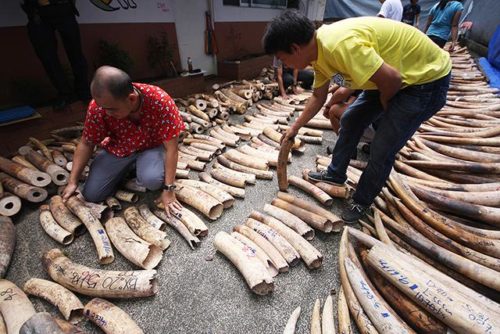
Chinese authorities have confirmed the capture and repatriation of the last of three of the key players in a massive ivory smuggling syndicate based in Shuidong, China.
In 2017, the Environmental Investigation Agency conducted undercover investigations into ivory smuggling in Mozambique and revealed a major Chinese-led crime syndicate operating out of the small Chinese town of Shuidong.
Over the course of more than a year, Agency investigators infiltrated the syndicate and uncovered the identity of ivory traffickers occupying key positions.
The findings were published in the 2017 report The Shuidong Connection: Exposing the global hub of the illegal ivory trade after the Agency had confidentially shared the information with the relevant Chinese authorities. The China Customs Anti-Smuggling Bureau launched an extensive raid involving up to 500 officers in several locations in Shuidong and surrounding areas.
One of the three key figures was caught during these raids and subsequently jailed for 15 years. Follow-up operations resulted in the apprehension of the second key ivory trafficker who was tracked down in Tanzania and voluntarily returned to China to face trial. He was jailed for six years. Finally, the China Customs Anti-Smuggling Bureau (ASB) announced on January 5, 2019 it had apprehended and repatriated the last of the three main culprits linked to the Shuidong wildlife crime syndicate, from Nigeria.
Shuidong’s geographical location is advantageous to its role as China’s main raw ivory trading hub. To the east lies Hong Kong, one of the world’s busiest ports and an important transit route for bulk ivory shipments. To the west lies Guangxi Province, which shares a porous border with northern Vietnam where the port of Hai Phong is another frequent transit route for ivory. To the north-east lies Fujian Province, one of the biggest ivory processing areas in China.
Local Tanzanians were tasked with sourcing the poached tusks and storing ivory safely at locations on the mainland until a load of about three tons had been collected. The contraband would then be transported to Zanzibar on small vessels and stored at warehouses for packing in a container, concealed in legitimate and low-value goods such as seashells, plastics or agricultural products.
One of the smugglers stated that only one in every 20 shipments was intercepted by authorities.
The Agency says that syndicates operating at this level were rarely specialists who trade exclusively in, for example, ivory. Traders instead seek to exploit legal loopholes, poorly regulated transport and logistic networks, and weak enforcement to trade in multiple threatened species. As well as elephant ivory, the Shuidong syndicate also traded in pangolins from Africa and Asia, totoaba fish maws from Mexico, rhino horn from Africa and had previously traded in sea cucumbers from Tanzania.
During the course of the investigation, the Agency witnessed the group shifting its operations from savannah elephant ivory to forest elephant ivory and pangolin scales. Pangolin scales are becoming increasingly attractive as an investment, as they are cheaper to source and less risky to smuggle; the profit margins are higher than for either type of ivory. These pangolin scales are being traded to dealers and traditional Chinese medicine producers in China, who then sell them on to pharmaceutical companies. The syndicate was able to move rapidly from one group of species to another, and the main factor driving the decision to trade or not is, of course, profit.
Source: Maritime Executive
